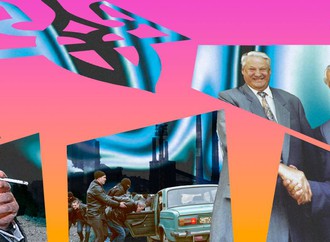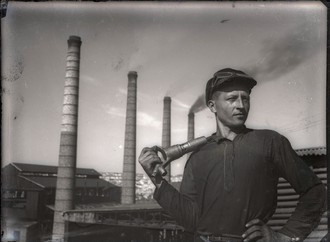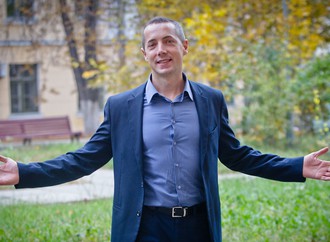In this chapter of his book, The Making and Unmaking of the Ukrainian Working Class: Everyday Politics and Moral Economy in a Post-Soviet City, Denys Gorbach offers an overview of Ukraine’s politico-economic landscape. He puts the economic transformations over the last thirty years in the political and cultural context. The first part covers the 1990s and Leonid Kuchma’s presidency; the second part analyses the politico-economic dynamics of the ‘oligarchic democracy’ starting from 2004. We published the abridged version of the chapter.
PART 2
Orange Revolution: Oligarchs and Identities
The presidential neopatrimonial model built by Kuchma did not survive the elections of 2004, which escalated into a set of contentious events, accompanied by mass mobilization inside the country and mediation by foreign powers. After the Supreme Court sanctioned a re-run of the second tour, the oppositional candidate Viktor Yushchenko narrowly won. The trade-off for the victory of the opposition, defined during the negotiations, was that the new president’s powers would be limited by constitutional reform: the centre of decision-making shifted to parliament. Such were the results of the political crisis of 2004, known as the Orange Revolution (Hale 2015: 182–90). In the course of this standoff, the liberal reformist camp presented its electoral struggle against the dominant ‘technocratic’ bloc in identitarian or even civilizational terms. The ‘party of power’, in its turn, played along, demonizing Yushchenko and his supporters as extreme nationalists, culturally and politically alien to the East.
The idea of ‘the two Ukraines’, first formulated in 1992, became a material force in the hands of political strategists. Since then, the Ukrainian political field has been constituted around the division between the ‘orange’ (national democratic, pro-European, neoliberal, Western Ukrainian) and the ‘white-blue’ (Russophone, pro-Russian, paternalist, Eastern Ukrainian) camps, according to the colours used in the 2004 campaign. The pre-existing divide was revitalized by constructing the myth of the Other. Western Ukrainians were stigmatized as biological and political heirs of wartime nationalist collaborators, whose backward economy did not entitle them to an equal share of the national income; for the other side, Russophones were associated simultaneously with the imperial Russia and the Soviet Union, symbolizing everything hostile and backward.
The major power shift of the Orange Revolution, thus, had at least two repercussions on different levels. The restructuring of the power configuration among oligarchs and top politicians was connected to a change of agenda in mainstream political narratives – from a discussion of socio-economic inequalities and corruption to a growing prominence of identity-based issues. Finally, this event signalled the interpenetration of geopolitical power struggles in the region with those inside the country: Viktor Yushchenko’s pro-Western rhetoric alarmed the Russian government, which lent its political and diplomatic weight to his opponent, constructed as ‘pro-Russian’.
Oligarchic Democracy: Elections and Conflicts
Initially, the new government tried to erase ancien régime oligarchs completely from the political and economic map. The prime minister Tymoshenko promised a massive revision of all privatization deals. However, by early 2006 the elite fractions found a relatively stable modus vivendi. The place of arbitrage moved to a large extent from the presidential office to parliament, becoming more public and dependent on electoral politics. The party political field was structured by three large blocs: the oppositional Party of Regions, headed by Viktor Yanukovych; the bloc of Yuliya Tymoshenko; and the party created by the weak president Viktor Yushchenko.
The scheme featuring a technocratic ‘party of power’ dominating a resource-poor ideological opposition came to an end. All serious contenders for power found themselves obliged to find an ideological face and use an ideology as additional leverage. Starting from 2005, the central government was directly invested in ethnonationalist identity-building on the basis of historical figures extremely controversial outside Western Ukraine, such as the wartime leadership of the Ukrainian nationalist underground. The ‘white-blue’ oppositionists headed by Yanukovych, on the contrary, reinvented themselves as defenders of ‘antifascism’, attracting a voter base by reviving Soviet commemoration practices (Kozachenko 2019). This actualized and perpetuated old and potentially irrelevant geographical divisions, filling them with new senses.
The identitarian divide, manufactured by elites during the 2000s, became a leverage that helped prevent a consolidation of power in the hands of a specific group. If one fraction of the ruling class went too far, the other could mobilize its voters against the perceived attack on their liberties from the other linguo-cultural group (Way 2015). However, it prevented not only a democratic curtailing but also neoliberal reforms explicitly targeting living standards of the population.
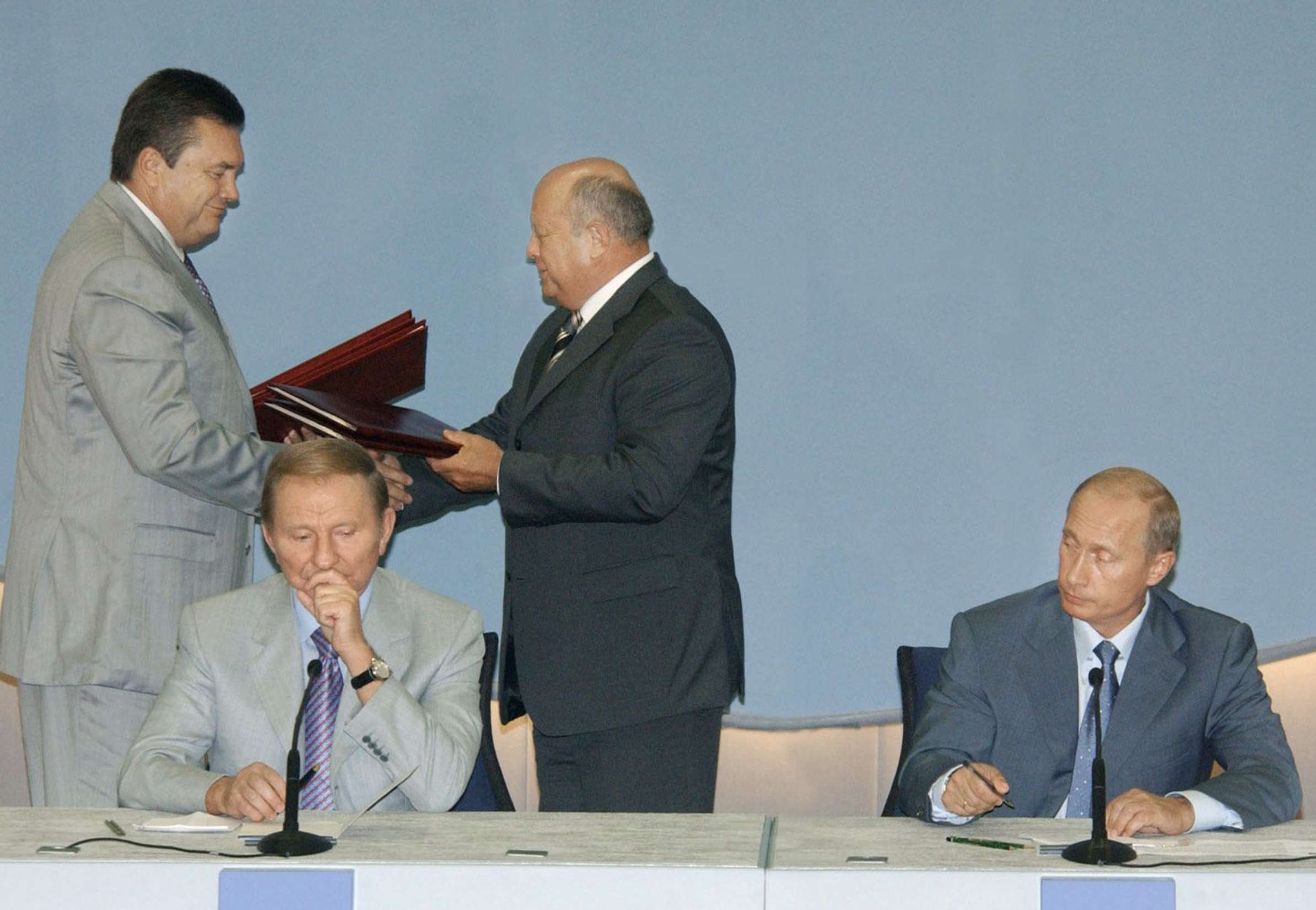
The heads of the governments of Ukraine and Russia Viktor Yanukovych and Mykhailo Fradkov in the presence of the presidents of Ukraine and Russia Leonid Kuchma and Vladimir Putin sign intergovernmental agreements, Sochi, August 18, 2004. Photo: TASS
Growth, Redistribution and the State
The precarious coalition between oligarchs and the working class could not rest exclusively on ideological cleavages; as with every hegemonic bloc, it needed economic growth in order to co-opt the dominated classes (Jessop 1983; Porto 2020; Scott 1976). Export-led growth, made possible by the 1997–2012 global commodity boom (Kolodii et al. 2018), provided the resources necessary for such co-optation: after the vertiginous fall of GDP in the 1990s (-8.9 per cent was the yearly average in 1990–1999), the average yearly growth in 2000–2008 was as high as 6.2 per cent. This did not fully compensate the previous fall – in fact the 1990 level has never been achieved – but the growth did create space for some sort of class compromise.
One of the first socio-economic measures taken by the new government was a radical increase of one-time parental payment for each new-born child. Its size, previously devalued by the hyperinflation of early 1990s, was increased to 22.6 times the living wage (‘living minimum’), making this payment the first major and direct evidence of the state’s redistribution role. Other welfare payments soon followed; the whole period in question was marked by consistently growing ‘social standards’ – minimum wage and other benchmarks that define the size of pensions and welfare payments, as well as wages in the public sector. During this whole period, wage share of GDP was systematically higher than that of profit. Every new government in the unstable political conjuncture was pushed to further raise standards of living, on pain of being declared ‘anti-popular’. Redistributionary rhetoric went together with communitarian rhetoric.
This conjuncture had demobilizing effects on the masses. Mihai Varga (2011) shows how political liberalization in the 2000s did not lead to a politicization of workers in the form of explicit social contestation. Instead, the main drive even for industrial conflicts came from gifted political leaders like Yuliya Tymoshenko, or from the opposing ‘white-blue’ elite networks (Kostiuchenko and Melnykovska 2019).
Oligarchs, who had to underwrite the expansion of redistributionist policies in order to maintain political control, found the trade-off reasonable in the context of the continuing economic boom. Profitability of their assets, expressed as s/(c+v), remained high thanks to two factors: the exceptionally cheap price that they had paid for these assets and the lack of significant expenses on modernizing the capital equipment mostly built in the Soviet times. From 2000 to 2014, the degree of deterioration of fixed capital steadily grew from 43.7 per cent to 83.5 per cent.
A more urgent problem was connected to the import-driven character of consumption in Ukraine. The growth of household incomes brought back permanent foreign trade deficit, after a short period of surplus in 1999–2005. The import of consumption goods was financed by the massive influx of capital from Western banks, attracted by high interest rates (Segura et al. 2009: 7). This external vulnerability was further aggravated by Russia’s hostile economic policies, which tried to stifle the ‘orange’ regime with high gas prices.
Economic Crises and Regime Changes
The global crisis of 2008 hit Ukraine severely. The slump in commodity markets hit exporting industries, and GDP contracted by 15 per cent in 2009, making Ukraine one of the hardest hit countries. Simultaneously, the global liquidity crisis provoked a massive outflow of foreign capital from the country’s banking sector. The government had to negotiate a $16.5 billion loan from the IMF and devalue the national currency by 60 per cent. On the IMF’s demand, the government froze wages in the public sector and increased excise taxes, further contributing to the rising cost of living.
This perfect storm for the government was aggravated by the split in the ‘orange’ elite bloc, which allowed Viktor Yanukovych to win the presidential elections of 2010. For the first time in Ukrainian history, a single political party came to dominate the country’s power structures: the new chairman of Yanukovych’s Party of Regions (PR), Mykola Azarov, became prime minister and distributed 2/3 of the cabinet positions to his party comrades. PR members also filled 90 per cent of all regional administrations. Later that year, the Constitutional Court reversed the political reform of 2004, re-empowering the president.
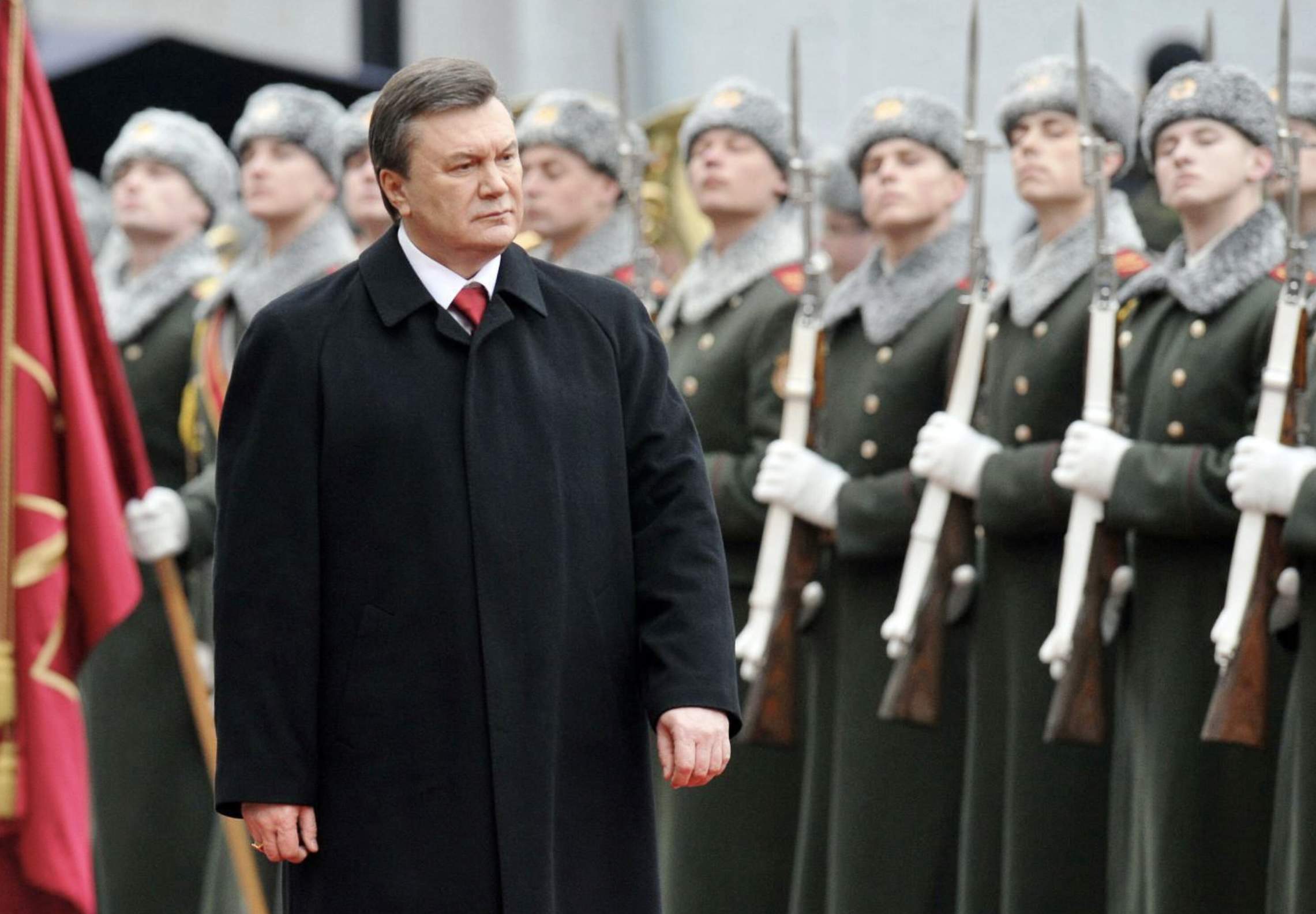
Inauguration ceremony of the President of Ukraine Viktor Yanukovych, Kyiv, 2010. Photo: AFP
In 2010, the Ukrainian economy started regaining its tempo. This was possible thanks to the rebound of global demand for steel and chemicals, as well as to domestic investments made in the course of organizing the European football championship in 2012. However, Russian natural gas prices kept growing, which undermined the budgets of energy-intensive oligarchic industries as well as the state budget that subsidized gas for households. The Russian government remained deaf to the pleas of the Ukrainian leadership, making all concessions conditional on Ukraine joining the Russia-led Eurasian economic union and abandoning plans of signing a free trade agreement with the EU (Cadier 2014). This option was no more acceptable to Ukrainian oligarchs, competing with Russian counterparts, than agreeing to the IMF-induced austerity.
Yanukovych thus continued a middle way: refusing Russian geopolitical offers, initiating instead the most extensive ever association agreement with the EU in 2012, and looking for alternative sources of fuels, on the one hand, and refusing to liberalize the domestic gas market, on the other (Pirani 2021). Thanks to the quantitative easing programme of the US Federal Reserve, Ukraine could find cheap money with no strings attached by Russia or the IMF (Tooze 2018).
However, Russia did not cease to promote its agenda. Starting from 2012, it launched a series of trade wars, blocking various Ukrainian imports: cheese, meat, dairy, confectionery, rolling stock, pipes. These measures were interspersed with official warnings against Ukraine signing a free trade agreement with the EU (Svoboda 2019). On the other hand, the EU made it clear that membership in the Russian customs union would be incompatible with a free trade agreement with the EU. Both partners occupied roughly equal shares in Ukraine’s trade balance, and it seemed to be impossible to sacrifice one for the sake of the other.
This dilemma coincided with the end of the global commodity supercycle (Chim 2021): prices for all commodities in which Ukraine specialized started stagnating or falling no later than in 2012. The Ukrainian economy demonstrated zero growth in the second half of 2012, and the growth did not resume in 2013.
The reduction of the state’s redistributional capacities happened in parallel to the growing consolidation of power in the hands of the president. Upon gaining extensive constitutional powers, Yanukovych started accumulating assets of his own, building a group that came to be known as ‘The Family’ (Semya) (Matuszak 2012: 40–50). The net assets of his eldest son doubled from $63 million in 2011 to $121 million in 2012 (Kudelia 2014: 22). This shift from collective authoritarianism to personalized autocracy introduced a new pattern of sharing rents and state resources, antagonizing traditional oligarchs.
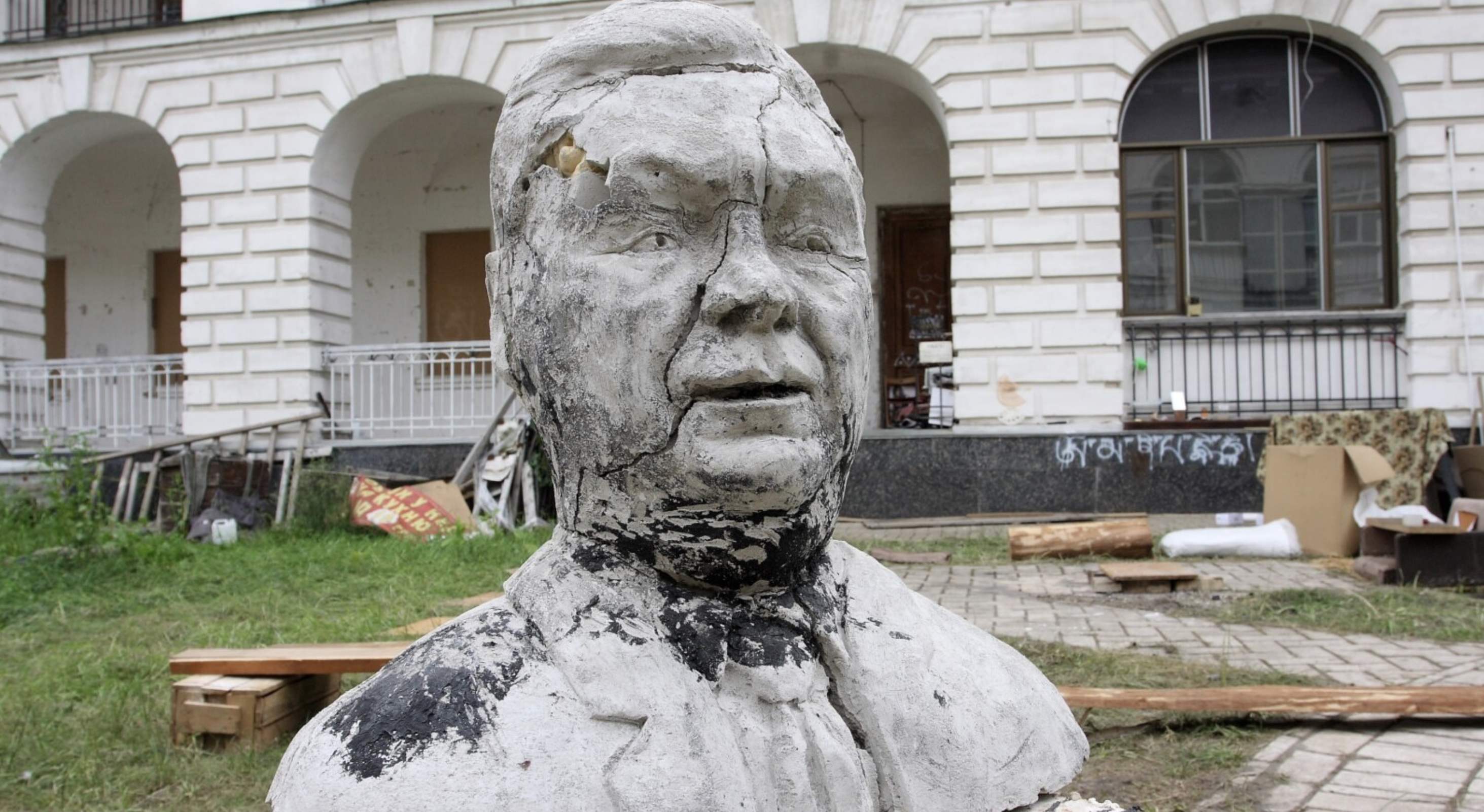
Sculpture of Viktor Yanukovych, made by Kyiv students, Kyiv, 2012. Illustrative photo
Finally, the other element of the political configuration of the early 2010s was a growing identitarian polarization. Experiencing a crisis of legitimacy brought about by the worsening economic conjuncture, the ruling group chose to reinforce it with the help of identity politics (Korostelina 2013). Instead of moving away from the ethnonationalist policies of his predecessor, Yanukovych reversed the ideological state apparatus to promote the opposite, ‘East Slavic’ version of identity. The role of the politics of memory as the regulator of ongoing political conflicts was growing (Shevel 2014).
A new language law passed by the ruling coalition in 2012 expanded the spheres of official use of Russian. It hardly had any influence on the real use of languages, but it mobilized society around an identity issue just months before the parliamentary elections. The far right ethnonationalist party Svoboda gained over 10 per cent of votes – a sensation facilitated by the party leadership’s constant presence on major pro-governmental TV channels. Despite the economic problems, it was thought that Yanukovych could easily win a presidential runoff in 2015 against the Svoboda leader Oleh Tiahnybok.
The ‘orange’ opposition, on its part, grew closer to the ultra-nationalists from Svoboda and ditched its traditional bland rhetoric of anti-corruption in favour of Svoboda’s ethnolinguistic agenda. This corresponded to a genuine mood among a large portion of voters. Even if these people did not share the views of the nationalists, they still appreciated their ‘genuineness’ as opposed to the cynical world of big politics.
Organic Crisis: 2014 and Afterwards
In November 2013, Yanukovych’s refusal to sign the Association agreement with the EU at the last moment triggered protests in Kyiv. They grew in scale after the police tried to disperse them by force; during the winter of 2013–2014, the protest movement expanded and radicalized. Numerically minuscule but equipped with violent resources, far-right groups managed to gain political prominence as the most militant part of the movement that otherwise had no clear ideological agenda (Ishchenko 2016). When the escalation of violence led to mass shootings, Yanukovych fled to Russia, and the ‘orange’ opposition leaders created an interim government. This is the short story of the movement, known as the Euromaidan in academia, as the Revolution of Dignity in the official discourse, and as the Maidan in common parlance (Hale 2015: 234–38).
These events were not limited to Kyiv. Beyond the capital city, protests and occupations of administrative buildings were disproportionately concentrated in Western Ukraine. People from the Eastern regions were mobilized to participate in the ‘Anti-Maidan’ by their employers in the public (biudzhetniki) and private (industrial workers) sectors. After the regime change, the Anti-Maidan protests took root and were radicalized. Politicians on both sides kept forcing the polarization, presenting to the public a choice between ‘Nazis and bandits’ (Ryabchuk 2014).
The international dimension of the conflict featured the US and Russia. The former was mostly engaged on the symbolic level, with the US secretary of state coming personally to distribute food among Euromaidan protesters. Russia’s engagement went beyond symbolic gestures: at an early stage of the protests, it offered Yanukovych a $15 billion loan and a gas discount without any conditions in terms of fiscal discipline (Svoboda 2019). When this aid failed to prevent the fall of Yanukovych, Russia covertly sent troops to annex Crimea and deployed armed pro-Russian separatists and military instructors to the Donbas area.
The snap presidential elections in May resulted in victory for Petro Poroshenko, a Russophone ‘orange’ oligarch with a very moderate political image. The new government had to deal with civil unrest, military conflict and the crumbling economy.
The New Structuring Divide
The military political conflict has radically restructured the identitarian see-saw that defined the pre-Maidan conjuncture. Poroshenko’s victory in the first round of elections was made possible by the massive abstention in the heavily populated ‘white-blue’ regions in the East and South. About 25 per cent of Yanukovych’s 2010 voters had been excluded from voting due to the conflict – their number was tantamount to all voters living in three Western regions. The new balance mathematically prevented a political force appealing primarily to South-Eastern voters from winning elections. As a result, reintegration of the separatist-held territories objectively ran against the interest of a ‘national democratic’ government aiming to consolidate power through selective enfranchisement (D’Anieri 2018).
At the heart of the new hegemonic bloc that the elite strove to build lay the loyalty to the event of Euromaidan itself rather than a specific ideology. Personal presence at the protests converted into a sense of belonging to the political nation, becoming the chief Schmittian political criterion structuring the post-Maidan Ukraine (Zhuravlev 2015). The new structuring divide, hence, lay between the ‘active’ citizenry loyal to Euromaidan (war veterans, civilian volunteers) and the rest of the population, whose main characteristic is ‘passivity’. Within the ‘active’ core, another divide separated partisans of liberal economic and social reforms supported by Western governments, on the one hand, and conservative nationalist forces, allied to the national bourgeoisie, on the other (Rakhmanov 2017: 66).
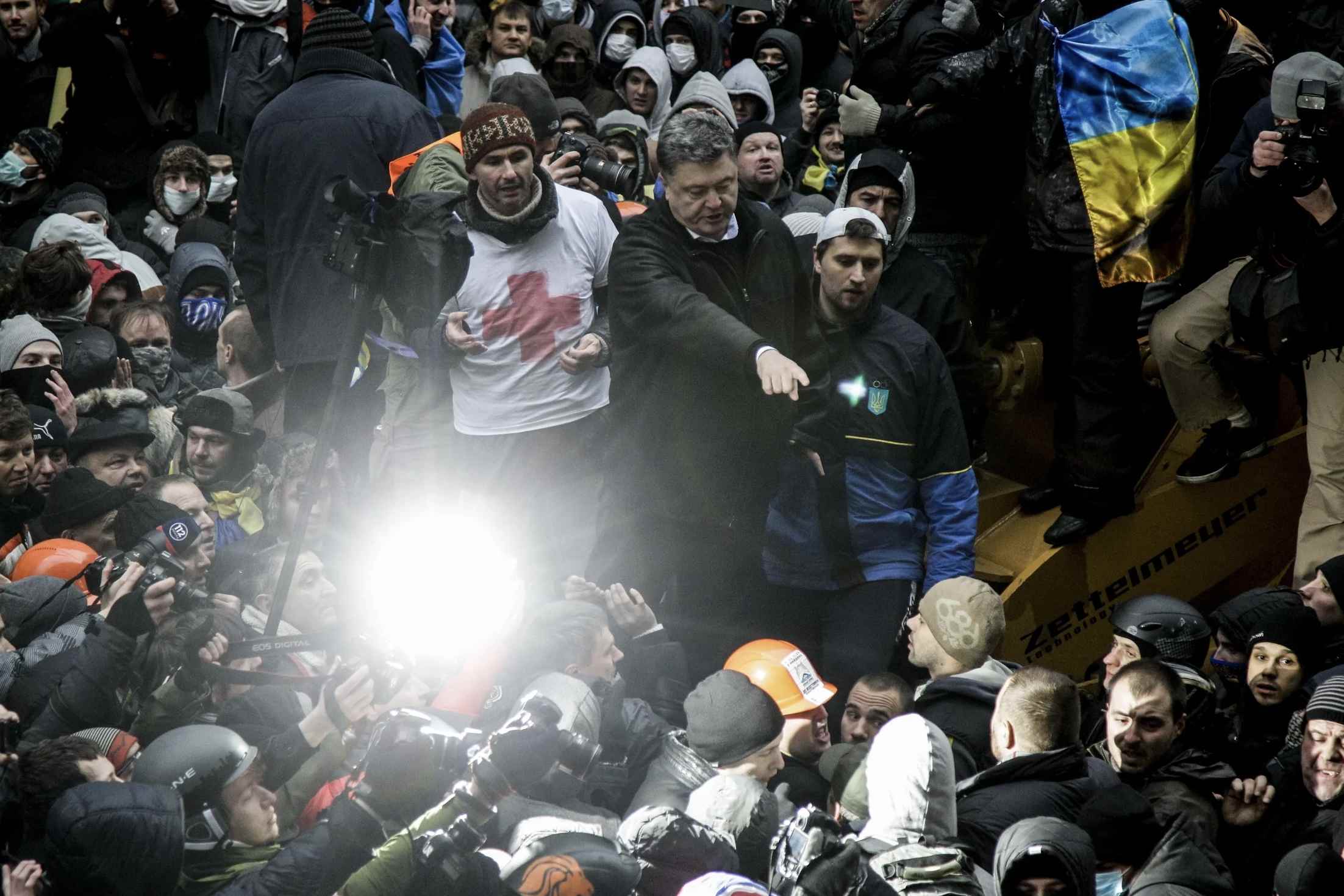
Petro Poroshenko during the Euromaidan. Photo: Yevhen Maloletka
Nationalist movements, previously marginal in mainstream politics, became an important element of both camps. Having built themselves into patronage pyramids on the national as well local levels, they were able to increase their influence dramatically, even if it did not translate into electoral success (Gomza and Zajaczkowski 2019; Gorbach and Petik 2016). Wielding substantial violent resources autonomously from the state, they assumed the role of entrepreneurs of political violence (Gorbach 2018).
Oligarchic networks have persisted despite the anti-oligarchic narratives of Euromaidan (Kostiuchenko and Melnykovska 2019). Unlike the Orange Revolution, Euromaidan did not take even symbolic steps towards opening the economy to competition from foreign capital. In 2017, 62 per cent of the largest companies in Ukraine were owned by domestic capitalists, compared to 29 per cent in Poland, 3 per cent in Hungary, and 0 per cent in Slovakia (Rakhmanov 2017: 62).
Legitimation Crisis
The military political crisis, to a great extent brought about by economic stagnation since 2012, in its turn provoked a fully-fledged economic downfall. In addition to the collapsed access to the Russian market, Ukraine was facing a direct loss of industries situated in the war-affected areas, indirect adverse consequences for supply chains, as well as the general strain that a military conflict puts on the economy. Eight billion USD, which Ukraine received from the IMF in 2014 and 2015, was not enough to prevent a drastic depreciation of the national currency by 70 per cent. In addition, the government had to agree to harsh austerity measures demanded by the IMF. The lifting of gas price caps led to a nearly tenfold hike in 2014–2016. This was an important blow to the regime’s legitimacy. Utility tariffs became one of the main political concerns of the population, along with the military conflict and language issues.
Facing a legitimation crisis, the government raised the ‘social standards’ as soon as the economic context allowed, doubling the minimum wage in 2016. This led to an enormous growth of average real wages in 2016–2017 (Astrov et al. 2020). The other step consisted of ramping up the jingoist rhetoric. Following the logic of the post-Maidan public sphere, Poroshenko took a harsh stance on the language issue, launched the ‘decommunization’ campaign and initiated the creation of an independent Ukrainian orthodox church. The main tagline of his presidential campaign in 2019 was ‘Language! Army! Faith!’.

A billboard with the political slogan of Petro Poroshenko's election campaign
Despite the consolidated support of the ‘active’ segment of Ukrainian society over-represented in the media, Poroshenko suffered a humiliating electoral defeat, losing to Volodymyr Zelenskyi, a comedian with no political experience. In the runoff with Poroshenko, he received an unprecedented 73 per cent of votes, erasing the geographical divide that had played such an important role for two decades. 25 per cent of Poroshenko’s votes were mostly concentrated in three Western regions. A few months later, the parliamentary elections brought a supermajority to Zelenskyi’s newly built non-ideological party, crushing local notables who had relied on local patronage for votes in majoritarian districts (Kudelia 2019). The electoral purge of the ruling elite highlighted the organic crisis but did not show any ways out of it.
Merging with Value Chains
The hegemonic crisis went along with the deepening accumulation crisis. The deterioration of capital remained well above 50 per cent. The modernization that did take place was aimed at maintaining technologies from the late 1980s and minimizing input demand, rather than introducing new technologies or switching to output with greater value added. The share of metalworking facilities operating beyond their designated service life reached 65–70 per cent (Shatokha et al. 2020). Steel production in Ukraine reached its peak in 2007, after which the global economic crisis combined with the increase in global supply by newly built Chinese factories to minimize the share of Ukrainian steel. Ukrainian steelmakers responded by sliding downwards in the global value chains, increasing the share of unfinished products and raw materials in their exports.
Simultaneously, the Ukrainian economy articulated with other commodity chains, namely agricultural ones. The 2009 recession reversed ‘the industrialised vigorous eastern area and the agrarian western area, which lagged behind the east, into respectively an industrialised stagnant area and an agrarian growing area’ (Kallioras and Tsiapa 2015: 89). The national economy has been reorienting towards grain production and export.
Moving Out: Demographic Response to the Crisis
The post-Euromaidan crisis conjuncture has a demographic dimension. Having reached its historical peak of 52.2 million in 1993, by 2019 Ukrainian population had shrunk to 42.2 million. During this period, the share of people aged 60 and older had grown from 18.7 per cent to 23.4 per cent, while life expectancy was only 72 years. These trends were exacerbated by the lack of significant migratory population inflows. On the contrary, Ukraine experiences massive emigration of the working-age population.
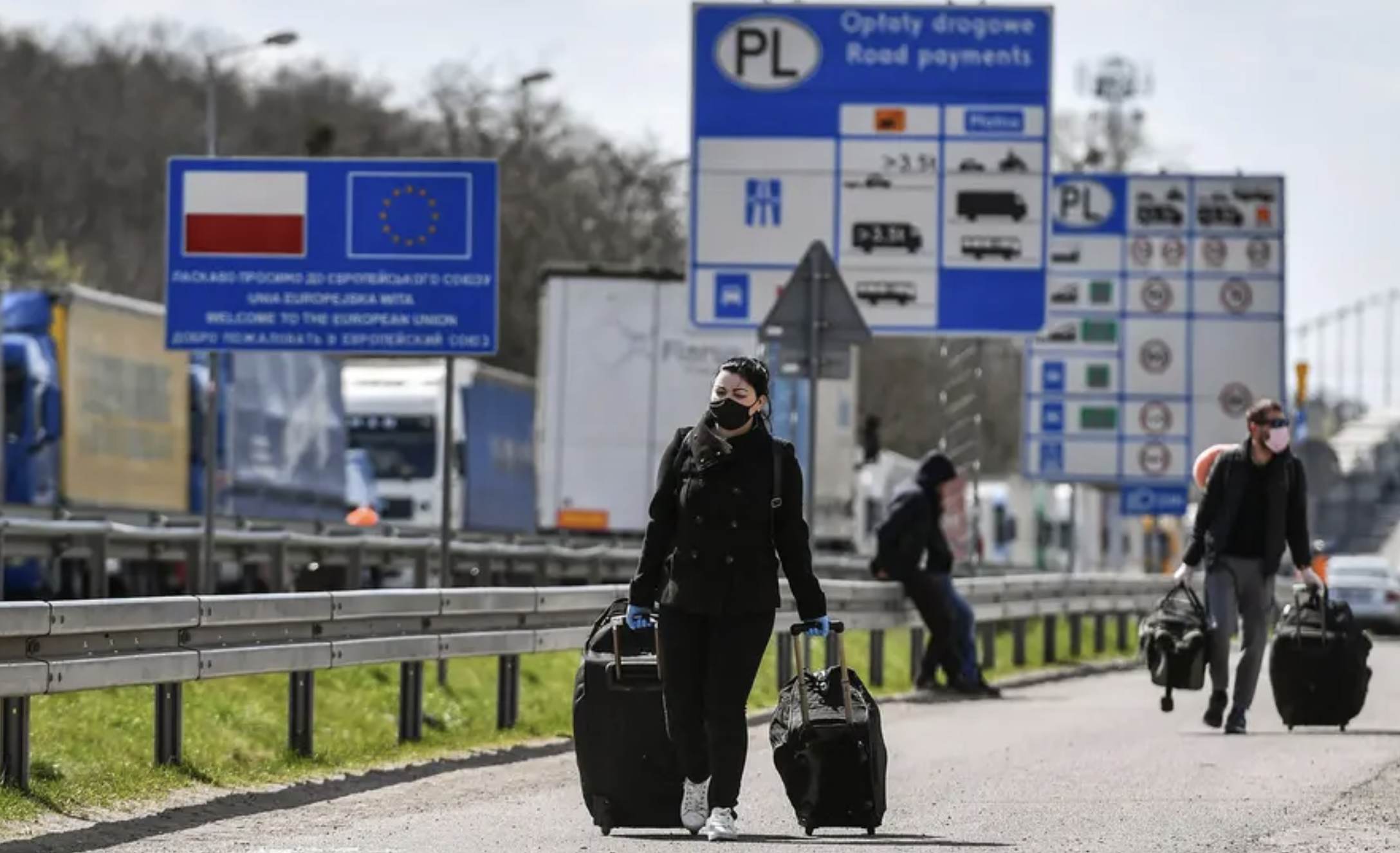
Citizens of Ukraine at the Polish-Ukrainian border crossing point "Yagodin-Dorogusk", April 17, 2020. At this time, many Ukrainian seasonal workers return home from Poland for Easter. Photo: EPA-EFE / WOJTEK JARGILO
CEE countries that joined the EU in 2004 have gone through a similar massive outflow of workforce, mending labour market deficits in Western Europe. Since 2014, the Ukrainian workforce has been effectively liquidating these deficits for these countries’ labour markets. The majority of first-time EU residence permits in 2018 were given to Ukrainians, most of them in Poland (Edwards 2020). After 1.2 million Poles left the country in 2002–2013, their places were taken by 1–2 million Ukrainians, who arrived in Poland in 2014–2019 (Growiec, Wyszynski and Strzelecki 2019).
Conclusion
Ukraine’s semiperipheral economy emerged out of a set of structural inequalities and dependencies, which defined the trajectory it took to fit into global markets. It is marked by tight interconnection of the domains of the economic and the political, and is exemplified by the term ‘oligarch’. An oligarch differs from a Weberian capitalist not only quantitatively (by the level of capital concentration) but also qualitatively – by his ability to command the nominally separate domains of politics and civil service, accumulating capital by converting it from one type to another.
Extreme concentration of capital, poorly protected ownership rights and the proliferation of informal channels connecting the economic and the political were as much the outcome of structural factors as the result of conscious attempts to create a national bourgeoisie. It arose as a fusion of the paternalist industrial nomenklatura, interested in the survival of their enterprises, and of profit-oriented entrepreneurs controlling supply chains and financial flows. As they concentrated a significant amount of industrial assets, their political clout grew, reaching the national scale, at which they entered a coherent political configuration centred on President Kuchma. This configuration was able to build a relatively durable hegemonic bloc by co-opting employees of oligarchic industrial enterprises and public employees dependent on the government. Material resources for securing these ties were provided by the global commodity boom that started in the late 1990s.
The resultant accumulation strategy relied on the use of material assets accumulated during the Soviet era. The use of offshore havens has allowed oligarchs not only to better protect their property rights but also minimize the volume of their fiscal contributions. These settings helped ensure a comfortable level of profitability. However, this satisficing strategy has set oligarchic industrial assets as well as public services on the track of constant underfinancing.
Politically, the ruling neopatrimonial pyramid was promoting centrist technocratic attitudes. Over time, it faced a new ‘national democratic’ opposition representing the interests of ‘lesser’ oligarchs. This opposition got the upper hand in 2004, dismantled the single president-centred pyramid and instituted parliamentary competition between various pyramids. In the public sphere, this competition increased identitarian polarization with each electoral cycle.
The end of the commodity boom in the early 2010s coincided with a number of other crises. Ethnolinguistic polarization reached unsustainable levels, threatening the very political system that relied on it; simultaneously, the system was undermined by the president’s attempts to centralize the neopatrimonial patronage dependencies into one pyramid, consolidating power and assets to the chagrin of oligarchs left behind. Finally, the interstitial geopolitical space between two competing projects of regional integration closed, putting an end to the era when the Ukrainian economy could combine multiple vectors in its foreign policy. The unstable politico-economic conjuncture completely unravelled with the Euromaidan crisis and the military conflict that followed in 2014.
The new balance of forces was still built on the principle of parliamentary competition of oligarchic patronage pyramids. However, it excluded the ‘East Slavic’ electorate from participation, assuming that a new hegemonic bloc could rely solely on the ‘ethnic Ukrainian’ identity. The failure of attempts to construct a new hegemonic conjuncture on these premises became manifest during the presidential and parliamentary elections of 2019. The population excluded from the new hegemonic project rejected it by massively voting for a populist comedian, whose sole promise was to remove the old political elite. This crisis of legitimacy has reconfigured the political field yet again, pitting the atomized majority of ‘populists’ against the nationalist bloc, which did not renounce its claims to national leadership. Neither camp has offered a convincing hegemonic project capable of co-opting important sections of society and identifying an accumulation strategy for the new global economic conjuncture. The full-scale Russian invasion that began on 24 February 2022 took place in this context of interregnum, carrying with it a possibility of finally consolidating society behind a widely shared national project but also the menace of its complete undoing.
References
Åslund, Anders. 2000. ‘Why Has Ukraine Failed to Achieve Economic Growth?’ Pp. 255–77 in Economic reform in Ukraine: the unfinished agenda. Armonk, N.Y: M.E. Sharpe.
Astrov, Vasily, Sebastian Leitner, Isilda Mara, Leon Podkaminer, and Hermine Vidovic. 2020. Wage Developments in the Western Balkans, Moldova and Ukraine. Research report. 444. Vienna: The Vienna Institute for International Economic Studies.
Balmaceda, Margarita Mercedes. 2009. Energy Dependency, Politics and Corruption in the Former Soviet Union: Russia’s Power, Oligarchs’ Profits and Ukraine’s Missing Energy Policy, 1995-2006. London; New York: Routledge.
Cadier, David. 2014. ‘Eastern Partnership vs Eurasian Union? The EU-Russia Competition in the Shared Neighbourhood and the Ukraine Crisis’. Global Policy 5:76–85.
D’Anieri, Paul. 2007. ‘Ethnic Tensions and State Strategies: Understanding the Survival of the Ukrainian State’. Journal of Communist Studies and Transition Politics 23(1):4–29.
D’Anieri, Paul. 2018. ‘Gerrymandering Ukraine? Electoral Consequences of Occupation’. East European Politics and Societies: And Cultures 088832541879102.
De Menil, George. 2000. ‘From Hyperinflation to Stagnation’. Pp. 49–77 in Economic reform in Ukraine: the unfinished agenda. Armonk, N.Y: M.E. Sharpe.
Edwards, Maxim. 2020. ‘Ukraine’s Quiet Depopulation Crisis’. The Atlantic. Retrieved 21 March 2020 (https://www.theatlantic.com/international/archive/2020/03/ukraine-eastern-europe-depopulation-immigration-crisis/608464/).
Fortescue, S. 2006. Russia’s Oil Barons and Metal Magnates: Oligarchs and the State in Transition. New York: Palgrave Macmillan.
Gomza, Ivan, and Johann Zajaczkowski. 2019. ‘Black Sun Rising: Political Opportunity Structure Perceptions and Institutionalization of the Azov Movement in Post-Euromaidan Ukraine’. Nationalities Papers 47(5):774–800.
Gorbach, Denys. 2018. ‘Entrepreneurs of Political Violence: The Varied Interests and Strategies of the Far-Right in Ukraine’. OpenDemocracy. Retrieved 2 May 2020 (https://www.opendemocracy.net/en/odr/entrepreneurs-of-political-violence-ukraine-far-right/).
Gorbach, Denys, and Oles Petik. 2016. ‘Azovskiy Shlyakh: Kak Ul’trapravoye Dvizheniye Boretsya Za Mesto v Politicheskom Menstrime Ukrainy (The Azov Road: How the Far Right Movement Fights for Its Place in Ukraine’s Political Mainstream)’. Forum Noveishei Vostochnoevropeiskoi Istorii i Kul’tury 13(1).
Growiec, Jakub, Robert Wyszynski, and Pawel Strzelecki. 2019. ‘The Contribution of Immigration from Ukraine to Economic Growth in Poland’. P. 27 in. Warszawa.
Hale, Henry E. 2015. Patronal Politics: Eurasian Regime Dynamics in Comparative Perspective. New York, NY: Cambridge University Press.
Ilyin, Ilya. 2020. ‘K Voprosu o Spetsifike Ukrainskoy Natsionalnoy Burzhuazii [Towards the Question of Ukrainian National Bourgeoisie]’. Commons. Retrieved 6 May 2020 (https://commons.com.ua/uk/k-voprosu-o-specifike-ukrainskoj-nacionalnoj-burzhuazii/).
Ishchenko, Volodymyr. 2016. ‘Far Right Participation in the Ukrainian Maidan Protests: An Attempt of Systematic Estimation’. European Politics and Society 17(4):453–72.
Ishchenko, Volodymyr, and Yuliya Yurchenko. 2019. ‘Ukrainian Capitalism and Inter-Imperialist Rivalry’. Pp. 1–19 in The Palgrave Encyclopedia of Imperialism and Anti-Imperialism, edited by I. Ness and Z. Cope. Cham: Springer International Publishing.
Jessop, Bob. 1983. ‘Accumulation Strategies, State Forms, and Hegemonic Projects’. Kalitalstate 10:89–111.
Kallioras, Dimitris, and Maria Tsiapa. 2015. ‘The Regional Dimension of Economic Growth in Ukraine’. Eastern European Business and Economics Journal 1(3):71–95.
Kolodii, Serhii, Inna Kochuma, Anatoly Marenych, and Mykola Rudenko. 2018. ‘Features of Functioning National Model of Resource Economics in Ukraine’. Financial and Credit Activity: Problems of Theory and Practice 4(27):359–69.
Korostelina, Karina V. 2013. ‘Identity and Power in Ukraine’. Journal of Eurasian Studies 4(1):34–46.
Kostiuchenko, Tetiana, and Inna Melnykovska. 2019. ‘Sustaining Business-State Symbiosis in Times of Political Turmoil: The Case of Ukraine 2007-2018’. Jahrbuch Für Wirtschaftsgeschichte / Economic History Yearbook 60(2):363–76.
Kozachenko, Ivan. 2019. ‘Fighting for the Soviet Union 2.0: Digital Nostalgia and National Belonging in the Context of the Ukrainian Crisis’. Communist and Post-Communist Studies.
Kudelia, Serhiy. 2010. ‘Betting on Society: Power Perceptions and Elite Games in Ukraine’. Pp. 160–89 in Orange revolution and aftermath: mobilization, apathy, and the state in Ukraine, Woodrow Wilson Center Press. Washington, D.C. : Baltimore: Woodrow Wilson Center Press : Johns Hopkins University Press.
Kudelia, Serhiy. 2012. ‘The Sources of Continuity and Change of Ukraine’s Incomplete State’. Communist and Post-Communist Studies 45(3–4):417–28.
Kudelia, Serhiy. 2014. ‘The House That Yanukovych Built’. Journal of Democracy 25(3):19–34.
Kudelia, Serhiy. 2019. ‘Rally around “Ze!” Flag: Ballots as Pitchforks in Ukraine’s Parliamentary Race’. PONARS Eurasia. Retrieved 8 August 2019 (http://www.ponarseurasia.org/point-counter/article/rally-around-ze-flag-ukraine-parliamentary-race).
Lankina, Tomila, and Alexander Libman. 2019. ‘Soviet Legacies of Economic Development, Oligarchic Rule and Electoral Quality in Eastern Europe’s Partial Democracies: The Case of Ukraine’. Comparative Politics.
Lytvyn, Volodymyr. 1994. Politychna Arena Ukraiiny: Diyovi Osoby Ta Vykonavtsi [Ukraine’s Political Arena: Characters and Performers]. Kyiv: Abrys.
Matuszak, Sławomir. 2012. The oligarchic democracy. The influence of business groups on Ukrainian politics. Warszawa: Ośrodek Studiów Wschodnich im. Marka Karpia.
Melnykovska, Inna. 2015. ‘Big Business and Politics in Ukraine: The Evolution of State-Business Relations’. Emecon: Journal for Employment and Economy in Central and Eastern Europe 5(1):1–14.
Minakov, Mikhail. 2019. ‘Republic of Clans: The Evolution of the Ukrainian Political System’. Pp. 217–45 in Stubborn structures: reconceptualizing post-communist regimes. New York, NY: Central European University Press.
Paskhaver, Oleksandr, L. Verkhovodova, and K. Agieieva. 2007. Velykyi Ukrayinskyi Kapital: Vzaiemovidnosyny z Vladoiu i Suspilstvom [Big Ukrainian Capital: Relationships with the Authorities and the Society]. Kyiv: Dukh i Litera.
Pirani, Simon, Jonathan P. Stern, Katja Yafimava, and Oxford Institute for Energy Studies. 2009. The Russo-Ukrainian Gas Dispute of January 2009: A Comprehensive Assessment. Oxford: Oxford Institute for Energy Studies.
Polese, Abel. 2008. ‘“If I Receive It, It Is a Gift; If I Demand It, Then It Is a Bribe”: On the Local Meaning of Economic Transactions in Post-Soviet Ukraine’. Anthropology in Action 15(3).
Popov, Vladimir. 2020. A Myth of Soft Budget Constraints in Socialist Economies. MPRA Paper. 99769. Munich Personal RePEc Archive.
Porto, Tiago Couto. 2020. ‘Coalitions for Development: A New-Developmentalist Interpretation for the Abandonment of Industrial Capitalist from PT Political Coalition’. Brazilian Journal of Political Economy 40(2):355–75.
Pynzenyk, Viktor. 2000. ‘How to Find a Path for Ukrainian Reforms’. Pp. 78–93 in Economic reform in Ukraine: the unfinished agenda. Armonk, N.Y: M.E. Sharpe.
Rakhmanov, Oleksandr. 2017. ‘Sotsialnaya Osnova Oligarhicheskoy Sistemy v Ukraine [Social Basis of the Oligarchic System in Ukraine]’. Sotsiologiya: Teoriya, Metody, Marketing (3):60–73.
Riabchuk, Mykola. 1992. ‘Two Ukraines?’ East European Reporter 5(4).
Riabchuk, Mykola. 2015. ‘“Two Ukraines” Reconsidered: The End of Ukrainian Ambivalence?: “Two Ukraines” Reconsidered: The End of Ukrainian Ambivalence?’ Studies in Ethnicity and Nationalism 15(1):138–56.
Rojansky, Matthew A. 2014. ‘Corporate Raiding in Ukraine: Causes, Methods and Consequences’. Demokratizatsiya 22(3):411–43.
Ryabchuk, Anastasiya. 2014. ‘Right Revolution? Hopes and Perils of the Euromaidan Protests in Ukraine’. Debatte: Journal of Contemporary Central and Eastern Europe 22(1):127–34.
Scott, James C. 1976. The Moral Economy of the Peasant: Rebellion and Subsistence in Southeast Asia. New Haven: Yale University Press.
Segura, Edilberto, Olga Pogarska, Oleg Ustenko, Larisa Kozyarivska, and Sergey Kasyanenko. 2009. Ukraine’s Financial Crisis: Past, Present and Future. Bleyzer Foundation.
Shevel, Oxana. 2014. ‘Memories of the Past and Visions of the Future: Remembering the Soviet Era and Its End in Ukraine’. Pp. 146–67 in Twenty years after communism: the politics of memory and commemoration. Oxford: Oxford Univ. Press.
Shpek, Roman. 2000. ‘Priorities of Reform’. Pp. 29–46 in Economic reform in Ukraine: the unfinished agenda. Armonk, N.Y: M.E. Sharpe.
Smahliy, Kateryna. 2006. ‘Patron-Kliyentarni Zvyazky Ta Prezydents’ki Vybory 2004 Roku [Patron-Client Relations and the 2004 Presidential Elections in Ukraine]’. Ukrayina Moderna (10):140–58.
Svoboda, Karel. 2019. ‘On the Road to Maidan: Russia’s Economic Statecraft Towards Ukraine in 2013’. Europe-Asia Studies 71(10):1685–1704.
Tooze, J. Adam. 2018. Crashed: How a Decade of Financial Crises Changed the World. New York: Viking.
Van Zon, Hans. 1998. ‘The Mismanaged Integration of Zaporizhzhya with the World Economy: Implications for Regional Development in Peripheral Regions’. Regional Studies 32(7):607–18.
Varga, Mihai. 2011. ‘Political Involvement in Industrial Conflict in Ukraine during the World Economic Crisis, 2008-2010’. Emecon: Journal for Employment and Economy in Central and Eastern Europe 1(1):1–19.
Wanner, Catherine. 1998. Burden of Dreams: History and Identity in Post-Soviet Ukraine. University Park, Pa: Pennsylvania State Univ. Press.
Way, Lucan A. 2015. Pluralism by Default: Weak Autocrats and the Rise of Competitive Politics. Baltimore, Maryland: Johns Hopkins University Press.
Yanitskiy, Andrei, and Graham Stack. 2018. Privatnaia Istoriia: Vzlet i Padenie Krupneishego Chastnogo Banka Ukrainy [Private Story: The Rise and Fall of Ukraine’s Largest Private Bank]. Kiev: Brait Star Pablishing.
Zhuk, S. I. 2010. Rock and Roll in the Rocket City: The West, Identity, and Ideology in Soviet Dniepropetrovsk, 1960-1985. Washington, D.C. : Baltimore, Md: Woodrow Wilson Center Press ; Johns Hopkins University Press.
Zhuravlev, Oleg. 2015. ‘From Presence to Belonging: Eventful Identity of Euromaidan’. Psychology. Journal of Higher School of Economics (12(3)):69–85.


